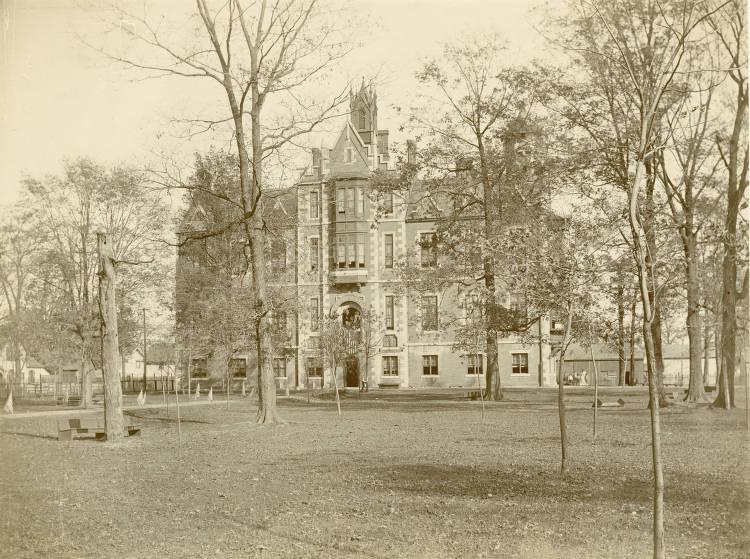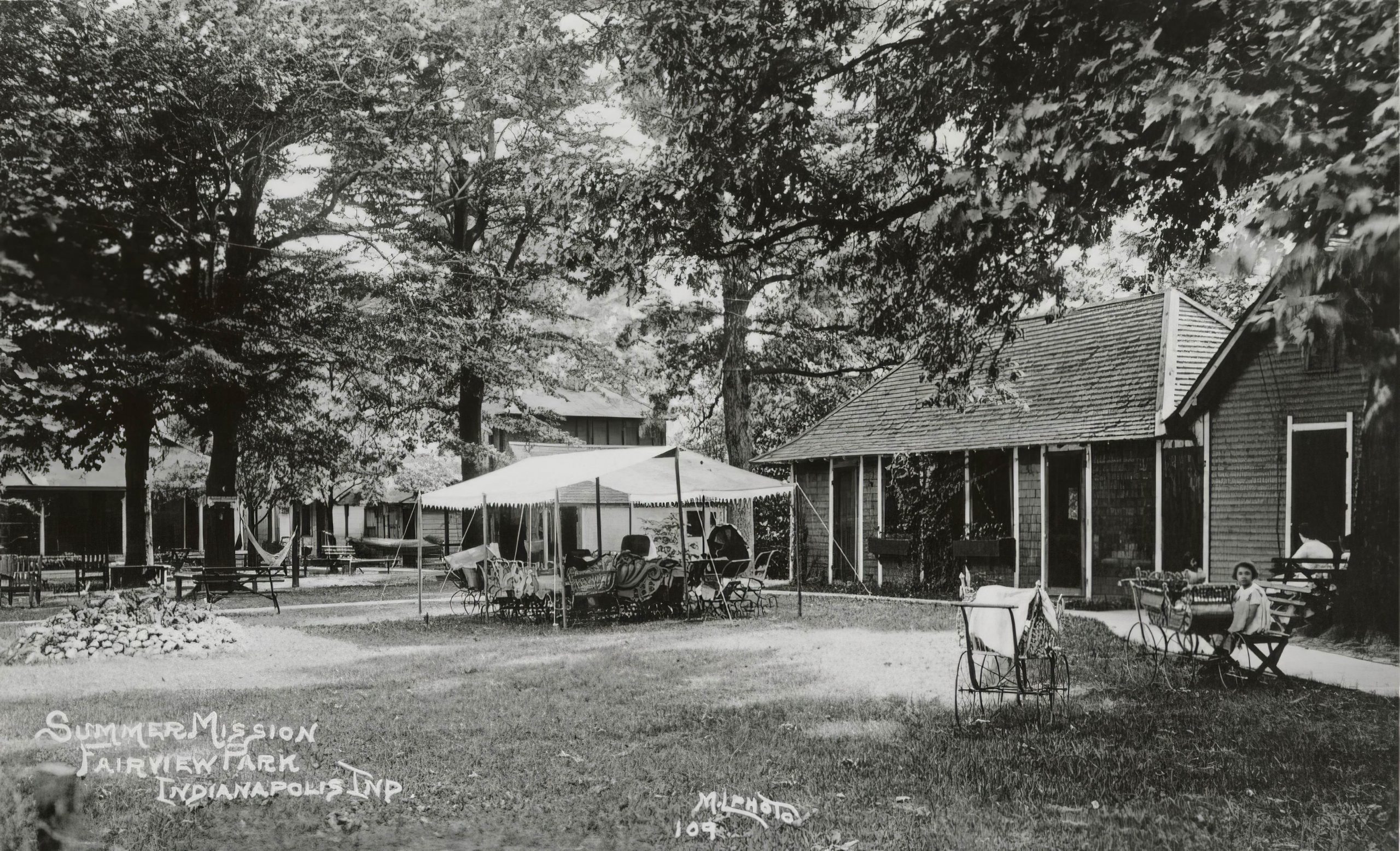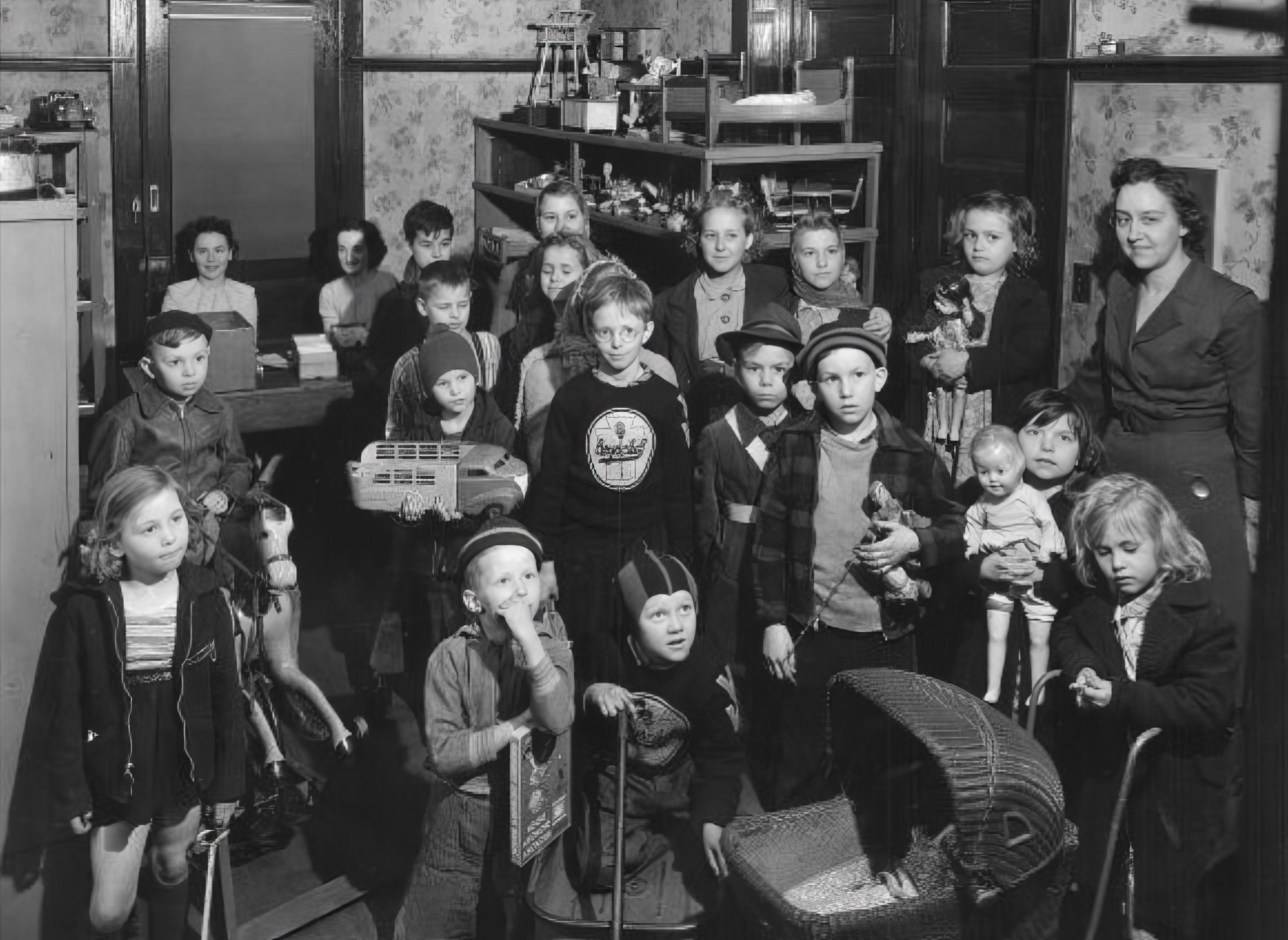Children’s Bureau and Families First merged to form Firefly Children and Family Alliance in 2021. Both organizations began as the Indianapolis Benevolent Society in 1835, making Firefly the oldest social service agency in the state.
During their long-shared history, the Children’s Bureau, Families First, and Indianapolis have witnessed numerous changes, including the , industrialization, immigration, population growth and diversity, both World Wars, the civil rights movement, engineering marvels, medical advances, global pandemics, and a technological revolution that is still underway. All these major developments can wreak havoc on family life, even against a backdrop of prosperity. Through all of this, “To strengthen family life” has remained at the heart of the mission for over 180 years.
Today as Firefly Children and Family Alliance, the Children’s Bureau and Families First, continue to work for the benefit of our Indiana communities.
Indianapolis Benevolent Society, 1835-1879
On Thanksgiving Day, 1835, businessmen and , attorney , and other early city civic leaders formed the Indianapolis Benevolent Society (IBS) “to relieve the necessities of the poor of the city of Indianapolis … by means of voluntary contributions.” It was only the fourth private poor-relief agency in the country and the first in the United States organized to meet the needs of individuals and families on a community-wide basis without regard to race or creed.
The society’s mission encompassed broader notions of community, to help individuals and families with personal problems, and “to strengthen family life.” The organizers personally supplied food, clothing, and sometimes money to supplement Marion County’s limited allocation of public funds for poor relief. They also looked for a more systematic method of collecting donations and aiding neighbors. The IBS was an entirely volunteer organization until 1879.
Children’s Bureau, Inc., 1850-2021
Members of the Indianapolis Benevolent Society created the Widows and Orphans Friends’ Society in 1850 “to relieve the physical, intellectual and moral wants of the widows and orphans of the city.” Originally, it paid private families to take in and care for individual orphans to accomplish its most pressing goals–to keep children out of the poorhouse and to keep mothers and their children together.
The all-female Widows and Orphans Friends’ Society board of managers raised funds through a door-to-door campaign. The women collected sufficient donations, including land, to open the city’s first orphanage, the Widows’ and Orphans’ Asylum, in 1855. A small advisory board of nine men provided expertise on philanthropy. , wife of future U.S. President , served as a manager and continued her affiliation while in the White House.

In 1855, the society acquired its first residence and expanded in 1869. By 1875, the asylum stopped housing widows and only cared for orphans, half-orphans (those with one parent), foundlings, and indigent children, and amended its name to the Indianapolis Orphans’ Asylum. The asylum bought a larger building in 1884 that housed over 100 children and provided a daily clinic and immunization program staffed by a doctor and nurse. It moved again in 1905 to a site with four buildings and a portable schoolhouse. The asylum served an average of 150 to 200 children.
The society established a public/private partnership when began boarding children at the orphanage and paying regular per-diem support for room and board. By 1867, both the Indianapolis and the County Commissioners appropriated regular funding. By 1882, circuit courts sent children from other Indiana counties to the orphanage in such numbers that aggregate public funding from “out county,” Marion County, and Indianapolis appropriations outpaced private donations.
By the 1920s, changes in social work ideology gradually shifted the asylum’s focus from institutionalizing children to providing individualized care and placing children in foster or adoptive homes. The Child Welfare League of America and the supported the professionalization of social services, and by 1930 social workers and a child psychiatrist on staff counseled the board, staff, and families and placed children outside the institution.
The asylum became the Children’s Bureau after merging with the Family Service Association’s Children’s Bureau in 1934 and hiring its first professional director. During this time, Marion County’s financial support declined and the Community Chest (see ) increased its annual funding. The Children’s Bureau Auxiliary was formed in 1932 to provide added fundraising and volunteer support. From 1932 to 2019, the auxiliary conducted a variety of fundraising events, supported special projects and programs, and donated thousands of volunteer hours. In 2019 the auxiliary became a committee of the Children’s Bureau development department.
The boarding population dropped throughout the 1930s and more children moved into individual homes. In 1941 the Children’s Bureau closed its orphanage and the General Protestant Orphan Home assumed care of the children. The Children’s Bureau turned its focus to adoptions, foster care, and counseling for unwed mothers and families. Though it was no longer running an orphanage, the Children’s Bureau did manage three group homes and placed more children in adoptive or foster homes during the 1960s than in any other decade.

After adoption placements peaked in 1970, the number of children up for adoption declined but children who needed foster or temporary care continued to increase. The Children’s Bureau expanded with additional group homes, programs designed for Black children, and services for children and teens with disabilities, backgrounds of abuse, or medical needs. In the 1980s the organization opened four temporary residential shelters.
Expansion continued during the 1990s and early 2000s. In 1990, the Children’s Bureau created a foundation to house its investments and generate income for its mission. The Children’s Bureau also assumed operations of the Family Support Center, Family Action Center (from Adult and Child Mental Health Center), the Anderson Family Resource Center (to serve Madison County), and Promising Futures (to serve ). The last group home closed in 2014, marking the end of the decades-long trend away from group homes and toward children’s placement in individual family homes.
The Children’s Bureau continued to offer a full range of child and family services and to operate a child abuse hotline until its merger with Families First in 2021.
Charity Organization Society, 1879-1921
The Indianapolis Benevolent Society (IBS) talked of disbanding after the economic depression of the 1870s. IBS leader Reverend , pastor of , invited Reverend Gurteen of Buffalo’s Charity Organization Society to speak at the IBS 1879 annual meeting. Gurteen’s presentation compelled civic leaders to create the Charity Organization Society (COS).
In 1879, in the law offices of future U.S. president Benjamin Harrison, the IBS established the Charity Organization Society (COS) and hired its first staff member. Its office in Plymouth Church on Monument Circle operated 24 hours a day and linked to the city using new technology for the time, the telephone.
The Charity Organization Society screened prospective clients and the Indianapolis Benevolent Society provided aid. Although they maintained separate identities, they functioned as two branches of the same organization and shared an executive and board of directors.
The COS provided relief to the deserving poor, reduced the causes of permanent dependency, and substituted work for relief. It investigated requests for assistance, maintained a confidential exchange of information for cooperating agencies, requested aid from appropriate agencies, and kept case records. To encourage thrift, it set up the Dime Savings and Loan Association, assigned volunteers to families to give advice about being thrifty and industrious, sponsored public lectures on the causes and cures of chronic poverty, and set up committees on the reduction of crime, municipal cooperation, penal and charitable institutions, and the cultivation of community gardens. The COS’s commitment to substituting work for relief led in 1880 to the Friendly Inn and Wood-Yard to provide work and lodging for transients.
During the summer of 1889, one of John and children fell ill. The heat aggravated the illness, prompting , founder of the , to write an editorial about the needs of poor children during the summer months. As a result, the Summer Mission for Sick Children opened under the auspices of the COS and in the style of “fresh air missions” conceived by the New York Children’s Aid Society.
The Summer Mission offered fresh air and free medical care in a pastoral setting several miles from the city at , the site of today’s . With a district nurse’s or doctor’s order, mothers and children received complimentary rail transportation to and from the mission, daily rest and meals, and nursing supervision. The formed the Fresh Air Fund and recruited children to raise money.

The COS and its related women’s organization, the Mothers’ Aid Society, also experimented with a “widows’ colony” for women and children without fathers. The organization again used Fairview Park where unemployed men built cottages that were offered rent-free to widows with children. It became known as Fairview Settlement because of its location. During the 1907-1908 depression, the COS partnered with the city to create public works jobs for other unemployed workers.
By 1910, Fairview Settlement included seven cottages, a central kitchen, grocery, laundry, Sunday school, and a day nursery. The COS promoted the Summer Mission and Fairview Settlement as national models, noting that “experts from New York and other cities have visited it and commended it highly.” The widows’ colony model fell out of favor and closed in 1920.
By the 1910s, competing child welfare programs made fundraising increasingly difficult. The Summer Mission, Cheeryvale (another summer camp located near ), the Children’s Aid Association, and Relief for Children consolidated their work in 1918. The Summer Mission kept its property and endowment funds and operated as part of The Children’s Aid Association. The camp closed in 1924 and sold the land to Butler University.
Family Welfare Society, 1922-1944
The Charity Organization Society, Indianapolis Benevolent Society, Children’s Aid Association, and Mother’s Aid Society merged in 1922 into a new organization, the Family Welfare Society (FWS), to address family problems. FWS functioned through two divisions: the Service and Relief Division, which had responsibility for family relief and rehabilitation, and the Children’s Bureau, which cared for children outside their own homes.

In 1934 the Children’s Bureau was transferred to what became the Children’s Bureau of Indianapolis. Following the establishment of government relief programs during the , the Family Welfare Society decreased its direct relief activities and focused on family casework. FWS assisted family members who could benefit most from counseling services: a widow adjusting to becoming the head of a household, a single father who wanted advice about household management, young couples willing to discuss marital problems, families with a genuine interest in budgeting, and those requesting vocational advice.
Family Service Association, 1945-1992
In 1945, the Family Welfare Society became the Family Service Association (FSA). The name change paralleled the national trend away from welfare, implying relief, toward services from which any family could benefit. The return to peacetime following brought families back together but introduced new challenges. Between 1946 and 1951, the number of families and people served more than doubled. By 1950, Family Service employed a staff of caseworkers who specialized in marriage and family counseling, household management, behavior and care of children, economic difficulty, mental or physical illness, aging, housing, and employment. FSA began charging nominal fees for services after caseworkers determined that many people refused help or advice if it came for free. Fees, however, covered less than one-tenth of the agency’s budget.
By 1960, Family Service had researched and adopted newer methods of family social work which involved all family members to solve family problems, including “family-centered casework” and group work. The 1960s brought several expansions. FSA added certifications with uniforms and insignia for better identification of home-based services. FSA opened a new branch in Hancock County, which still operates today. The organization continued to adopt new services: intervention for abusers, adult guardianship, Employee Assistance Programs, and mediation. Partnerships grew, including the Visiting Nurse Service (see ).
Family Service Association of Central Indiana, 1993-2010
In 1993, the agency became the Family Service Association of Central Indiana. FSA followed the 1990s national emphasis on outcomes and increasingly focused on program evaluation. FSA acquired two programs from other organizations: Breaking Free, a domestic violence program, and a Child’s Haven childcare services.
Families First, 2011-2021
In 2011, Family Service Association of Central Indiana became Families First. Along with this change, the organization expanded its offerings and began to provide advocates to the Marion County Court to help victims of violence obtain protective orders. The agency also began offering counseling services to students at . In 2016, Families First acquired Mental Health America of Greater Indianapolis, bringing with it additional adult guardianships, public education, and a 24-hour crisis and suicide hotline.
Firefly Children and Family Alliance, 2021-
Children’s Bureau and Families First merged to form Firefly Children and Family Alliance on April 1, 2021. Preserving and supporting families historically drove the mission of both organizations and served as the common ground for the merger. Holistic service to families, especially children, remains the mission of the new agency.

Help improve this entry
Contribute information, offer corrections, suggest images.
You can also recommend new entries related to this topic.